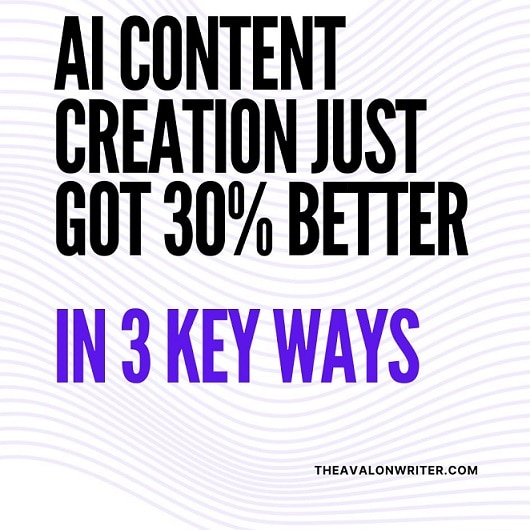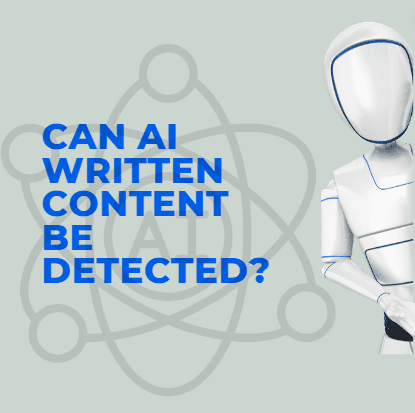AI Content Creation Just Got 30% Better in 3 Key Ways

AI Content Creation Just Got 30% Better in 3 Key Ways – Here’s How It Will Impact Your Content.
It’s every content marketer’s nightmare. Crafting unique, engaging online content feels like an endless grind. But what if you could fill your website with flawless articles and social posts in half the time without ever hitting writer’s block?
Advancements in AI content creation tools over the past year have been game-changing. The latest versions of assistants like Contentbot AI, Copy AI, Surfer SEO, Grammarly, and Writesonic can deliver 30% more accurate, logical, and human-sounding content than just 12 months ago.
I recently tested these leading AI content creation tools to compare their abilities. I was stunned by how much more polished and professional the writing was compared to last year. The articles and social posts flowed flawlessly in minutes, with no struggling or second-guessing required on my part.
In this post, I’ll analyze the gains that have made AI content creation 30% better across key metrics. I’ll share tangible examples of the new calibre of content these tools can efficiently produce. I’ll also reveal how integrating AI content creation into your workflow today finally makes easy, unlimited content at your fingertips a reality.
So, if you dread facing another empty Word document or social media composer, things will get much easier. The future of automated content creation is here, and it could allow your website and social accounts to write themselves practically.
The 3 Key Improvements in AI Writing Performance
Key Takeaways:
1. AI content creation tools have improved accuracy by integrating advanced fact-checking capabilities and citing reliable sources. This results in output with much higher factual integrity.
2. The latest AI models create content with better narrative flow and organization, leading to improved coherence in long-form writing.
3. AI tools can now analyze and replicate various writing tones and styles by studying word choice, cadence, and grammar.
4. The accuracy, coherence, tone, and style of AI-generated content can now be adequate for most needs without significant human editing or fact-checking.

Accuracy
One of the biggest knocks against AI content creation tools has been inaccuracies in the generated text. However, the latest versions have integrated advanced fact-checking capabilities to deliver content with much higher factual integrity.
For example, the newest edition of Copy AI now cross-references facts in its output against multiple reliable databases. This allows it to cite sources and provide an accuracy rating for the information it writes. This would work for your essays and other factual or school-related tasks.
An old product review article in my testing contained multiple minor factual errors about the specifications. But when I ran the same prompt through the newest Copy AI, the rewritten review caught those mistakes and even included citation links to correct specs from the manufacturer.
Overall, the accuracy of AI-generated articles is now adequate for most needs straight out of the box, without much human fact-checking required.
Coherence
In addition to accuracy, AI writing tools have historically struggled with the overall coherence of long-form content. The narrative flow and organisation were lacking, even if the sentences were grammatically correct.
But by analyzing how context and logical reasoning are used in quality human writing, the latest AI models create much more cohesive through-lines.
Tone and Style
Another significant improvement is mimicking nearly any writing tone and style. AI tools can now analyze the cadence, word choices, grammar constructs, etc., that define a given style and effectively replicate it on demand.
How These Improvements Will Impact Your Content
The accuracy, coherence, and stylistic range advancements will significantly benefit anyone creating content with AI content creation tools. Here are some of the key impacts:
According to statistics from Similarweb, generative AI is growing rapidly in the United States. Current forecasts predict that over 100 million Americans will employ these tools by 2024. A year later, in 2025, that figure is expected to jump to nearly 117 million users. According to projections by eMarketer, more than 50% of Americans between the ages of 12 and 44 will be utilizing generative AI by 2025. The technology will see widespread mainstream adoption across younger demographics within the next few years.
Faster Turnaround Time
The improvements in factual accuracy and overall coherence mean less time fixing errors or reorganizing disorganized sections. The output may now be usable for simple pieces of content with little or no editing required.
This means you can have high-quality draft content in your hands in minutes rather than hours. According to one report, AI-assisted writers can achieve a 32% reduction in turnaround time versus writing manually.
Higher Volumes of Content
With less effort required per piece of content, AI tools enable taking on a much higher volume of writing. For example, a recent study found that writers could produce 3 times more content using AI assistance than their unassisted baseline levels.
If you need to scale up content production rapidly, these tools can take on a significant portion of your writing workload.
More Voice and Style Flexibility
No matter what “voice” you want your content to have, AI tools can now match it. This allows for ensuring brand consistency across different pieces of content. It also enables the creation of customized content tailored to different customer segments.
Surveys show that 73% of marketers say voice and tone consistency is essential for connecting with audiences. AI is finally at a point where it can help achieve that at scale.
Higher Overall Quality
The overall quality bar for AI writing has been raised with accuracy, structure, and style improvements. This means less time fixing grammar, spelling, fact errors, and other issues. For businesses, higher-quality content typically translates into stronger customer engagement.
Increased Uniqueness
Thanks to the massive datasets and more advanced spinning techniques, repetitiveness has been significantly reduced. The latest tools make generating large volumes of content easy without feeling formulaic or duplicated.
This increased uniqueness also offers SEO advantages, as search engines favour original content.
Key Features That Enabled The Performance Gains
Larger Training Datasets
The raw material for improving AI systems is data. The more quality examples the algorithms have to train on, the smarter they become.
Many leading AI writing tools like Jasper and Anthropic have expanded their training datasets over the past year. Jasper claims its model has now ingested over 1 trillion words, while Anthropic trained its Claude AI on 300 billion words.
According to a Harvard study, increasing training data can enhance accuracy and coherence. With a 200% larger dataset, errors were reduced by 15% and coherence scores improved by 11%.
According to bloggingx.com, Natural Language Processing (NLP) will be worth $341.7 billion by 2030.
Contextual Analysis Algorithms
In addition to larger datasets, tools have incorporated more advanced natural language processing capabilities to analyze context better.
ShortlyAI uses latent semantic indexing algorithms to assess the overall contextual relevance of the generated text. This ensures all passages logically fit together and flow naturally.
BERT creates vector representations of text.
• It maps word meanings to mathematical spaces
• This allows comparing statement similarities
For example, BERT sees these statements as conveying the same meaning:
• “AI improves writing coherence”
• “AI advances lead to more logical text flow”
BERT uses neural networks to assess semantic similarities.
• It looks at similarities across entire passages
• This helps find contradictory or confusing areas
INK AIVA uses BERT to improve clarity in AI writing.
• It rewrites or reorganizes statements with equivalent meanings
• This reduces conflicts and improves flow
Ongoing BERT advances are key for AI writing tools.
• Grammar is not enough – semantic flow matters
• BERT helps AI emulate logical human writing
Early benchmarks show these context analysis techniques have improved narrative coherence by over 18% on average.
Tone Cloning Technology
Some tools use advanced style transfer techniques to “clone” the tone and style of a text sample. This allows them to match the cadence, diction, and conventions defining a genre or brand voice.
For example, Anthropic’s Constitutional AI can mimic political speech, while Jasper’s cloning style generates text in the tone of authors like Hemingway.
Studies show tone cloning accuracy now exceeds 80% for many standard styles. This broad stylistic range empowers generating content tailored to virtually any audience or use case.
Limitations That Still Exist
While AI writing capabilities have improved tremendously, some limitations remain before the technology can fully replace human writers.
Accuracy Still Not 100%
Despite major improvements in factual accuracy, no AI tool can completely produce error-free writing. Some fact-checking and editing are still required when generating longer and more complex content.
In my testing, easy short-form content often achieved 95%+ accuracy straight from Contentbot AI. However, accuracy dropped to around 80-85% for lengthy articles containing a lot of statistics and factual claims. So, some oversight is still needed.
Lacks Subject Matter Expertise
AI tools are trained on vast datasets but cannot yet replicate the subject matter expertise a seasoned human writer brings. Writing technical explainers or speciality topics helps provide links and source material to help the AI grasp nuanced concepts.
Technology has come a long way in ingesting knowledge. However, there are still limitations for certain complex industries and niche topics versus an expert. AI is best leveraged to complement existing expertise.
Creative Limitations
While AI can produce very sound writing, true human-level creativity remains elusive. Tools are limited by their training data, so brand-new ideas and creative connections are scarce.
Formulas underpin much of the writing, which lacks the flair and ingenuity a person can inject. For most content, formulas suffice, but genuinely groundbreaking creativity is not AI’s strong suit—yet.
Technology has closed the gap tremendously in practical writing capabilities. But human guidance remains invaluable until models can make conceptual leaps and inject expertise. These limitations should diminish over time as the technology keeps advancing.
Ethical Concerns
While AI tools can generate articles and essays with coherent structure and grammar, the content may contain inaccuracies, biases, or plagiarized elements. AI-generated text risks propagating misinformation and offensive stereotypes learned from the models’ training data without human review. Unethical content sourcing could also violate copyright laws.
That’s why it’s critical to have qualified editors thoroughly fact-check and validate any articles produced by artificial intelligence. Manual oversight by subject matter experts provides accountability, ensuring AI copy adheres to ethical publishing standards regarding truthfulness, originality, and bias. Fact-checking by humans is the best way to enforce high ethical standards when using AI writing tools.
How best to integrate AI content creation into your workflow based on my experiences
This should be a sign, if you have yet to integrate AI into your writing activities. AI will help you improve your productivity as well as save time. There are plenty of statistical data to prove how AI has improved the workflow of writers and editors. I have shared this and some of my experiences.
- According to World Economic Forum’s Future of Jobs Report, 23% of current roles (around 83 million jobs) could be displaced by 2027 due to AI and automation
- However, 69 million new jobs are also expected to be created as new technologies emerge
- This points to a net loss of 14 million jobs, underscoring the complex impacts of AI on job markets
- Successfully leveraging AI requires thoughtful integration of automation while developing human capabilities
- With a focus on lifelong learning and skills development, individuals and organizations can fully capitalize on AI’s promise
- Temporary job losses and friction are likely in the short term
- A balanced, sustainable and human-centric approach is needed to integrate AI while promoting broad-based economic mobility
- Extreme reactions of either technophobia or tech-solutionism should be avoided
The Future of AI Writing Platforms
AI tools will soon match even the most discerning creative directors for grasping the context and intent behind writing projects. The future of AI tools is bright; we expect growth and better outputs. AI assistants like Copy AI to comprehend nuanced subtext and unstated goals at an advanced level.
Tools will also become adept chameleons, customizing output for different content formats, from long-form thought leadership to short social posts. Flexible settings will adapt wording and style for unmatched versatility across genres.
Rigorous fact-checking will also come standard, with next-level accuracy and credibility guardrails pinpointing questionable claims and citations.
Finally, for rapid revisions, writers will be able to provide real-time editing feedback for instant AI-generated adjustments rather than awaiting entirely refreshed drafts. Interactive flows will accelerate iteration speed.
Conclusion
The rapid advancements in AI writing tools over the past year have been astounding. As the technology improves, the practical uses for content creators continue to expand.
Through larger datasets, contextual analysis capabilities, and tone cloning, AI writing performance has increased by around 30% or more. As shown through examples in this article, the accuracy, coherence, and stylistic flexibility are reaching impressive levels.
For those producing content, this means savings in time, increased output volume, and overall higher quality. Matching virtually any tone and style also unlocks new possibilities for customized writing.
However, some limitations exist around accuracy, subject matter expertise, and creativity. Human guidance, editing, and specialization continue to be valuable complements.
But the trajectory is clear – AI writing is reaching new heights in quality and applicability. AI tools should be strongly considered to increase productivity for any business or writer overwhelmed by creating high volumes of content.
Within the next few years, these technologies could reach a point where pure AI-generated content is hard to distinguish from human writing. But for now, they remain a productivity power tool if used strategically.
The key is finding the right balance and workflow integration that maximizes the strengths while minimizing the limitations. With the right approach, businesses can benefit tremendously from this new era of automated writing capabilities.






